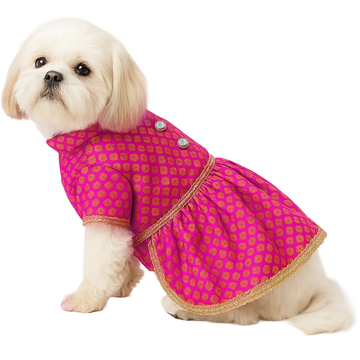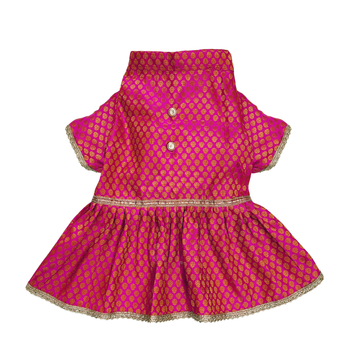Rhodesian Ridgeback

Rhodesian Ridgeback
| Breed Highlight: |
|
The Rhodesian Ridgeback is a large sighthound dog breed bred in the Southern Africa region. Its forebears can be traced to the semi-domesticated ridged hunting and guardian dogs of the Khoikhoi. These were interbred with European dogs by the early colonists of the Cape Colony of southern Africa. |
| Weight: |
|
29 – 41 kgs |
| Height: |
|
61 – 69 cms |
| Life Expectancy: |
| 10-13 years |
| Litter Size: |
| 13-17 Puppies. |
| Breed Appearance: |
|
The first thing people notice about the Rhodesian Ridgeback is usually the characteristic ridge that runs down his spine and gives him his name. The ridge reveals part of his heritage, which is a mix of European hunting dogs and African dogs who had the distinctive ridge. They also notice his strong athleticism, noble carriage, and intelligence in his eyes. The history of the breed only adds to its allure; owners are often asked, "Did they really hunt lions?" |
| History: |
|
The Rhodesian Ridgeback is a unique creation of southern Africa, resulting from crosses between the native ridged Khoikhoi dog and European breeds brought by Dutch colonists, the Boers, including Greyhounds and various Terriers. The infusion of native Khoi blood gave resulting generations a resiliency against local pests such as the tsetse fly, as well as an inborn knowledge of how to navigate their new African environs – and outwit its deadly predators. In the late 19th Century, big-game hunter Cornelius van Rooyen from Rhodesia incorporated two ridged Greyhound-like females into his pack of lion dogs. He found that their ridged offspring excelled at confronting and confounding the king of beasts, giving the hunter time to sight in his rifle and dispatch his prey. These ridged dogs were also successful at fending off other dangerous animals such as leopards and baboons, trotting effortlessly alongside horse-mounted riders all day, breaking off to course quick-footed game such as antelope to provide meat for the pot, and protecting the homestead from all intruders. They were known then, as they are today, for their devotion to family, and tolerance and affection for its children. In 1922, a meeting was convened to write the first Rhodesian Ridgeback standard. By then, big-game hunting had already begun to fade in South Africa, and the breed itself was on the brink of extinction. The dogs convened at this meeting ranged in size and appearance from Bull Terriers to Great Danes, and the Dalmatian standard was used as a template to arrive at the standardized vision of the breed that we know today. |
| Originally: |
|
South Africa |
| Currently Used As: |
|
The Rhodesian Ridgeback is an all-purpose 'Renaissance hound' whose hallmark is the ridge, or stripe of backwards-growing hair, on his back. Though the breed was made famous in its native Africa for its skill at tracking and baying, but never, ever killing, lions, today Ridgebacks are cherished family dogs whose owners must be prepared to deal with their independence and strong prey drive. Today, the Rhodesian Ridgeback is still used for hunting, and some members of the breed have even adapted to pointing and retrieving. The Rhodesian Ridgeback can also be found competing in various dog sports, including agility, lure coursing, obedience, and tracking, and he's good hiking or jogging companion. |
| Training: |
|
Because of their very strong prey drive, Rhodesian Ridgebacks should always be in a safely enclosed area when off-leash. The Ridgeback is a devoted companion and needs to live indoors with his human family. They can be strong-willed, independent, and sometimes domineering, and must be guided with a firm but a patient hand from early puppyhood. Early socialization and puppy training classes using positive reinforcement are recommended and help to ensure that the dog grows into a well-adjusted, well-mannered companion. |
| Health & Care: |
|
Rhodesian Ridgebacks are generally healthy, but like all breeds, they can get certain health conditions. Not all Ridgebacks will get any or all of these diseases, but it's important to be aware of them if you're considering this breed. If you're buying a puppy, find a good breeder who will show you health clearances for both your puppy's parents. Health clearances prove that a dog's been tested for and cleared of a particular condition. In Rhodesian Ridgebacks, you should expect to see health clearances from the Orthopedic Foundation for Animals for hips, elbows, and thyroid and from the Canine Eye Registry Foundation (CERF) certifying that the eyes are normal. Because some health problems don't appear until a dog reaches full maturity, health clearances aren't issued to dogs younger than 2 years old. Look for a breeder who doesn't breed her dogs until they're two or three years old. Rhodesian Ridgebacks can adapt to a variety of homes, including apartments, as long as they get daily exercise. They should live in the house with their people, not outdoors in a run or kennel. Access to a securely fenced yard is ideal. They'll try to escape if bored, so in addition to ensuring that your fence can't be jumped or climbed over or dug under, keep your Ridgeback busy with training, play, or dog sports. Sending him out into the yard by himself for hours on end is an invitation to destruction. Even if he's not especially bored, a Ridgeback is often inclined to dig large holes so he can rest in the cool and comfortable dirt. Be prepared to give him part of the yard or resign yourself to having a cratered yard that resembles the surface of the moon. Give your Rhodesian Ridgeback a couple of 15- to 20-minute walks or playtimes daily, plus opportunities to run in a safely fenced area a couple of times a week. Because of the breed's strong prey drive, keeping him on a leash in unfenced areas is a must. Your Ridgeback will take off after a cat, rabbit, or bicyclist, no matter how well you think he's trained. Ridgebacks are generally discriminating barkers, meaning they only bark at things that are important, but any dog can become a nuisance barker if he doesn't have anything else to do. Begin training early, first with puppy kindergarten, followed by a basic obedience class. The Rhodesian Ridgeback has a mind of his own and can be stubborn. To train him successfully, you must be firm and consistent but not harsh. Use positive reinforcement techniques such as praise, play, and food rewards. |
| Living Condition: |
|
Ridgebacks also would like very much to run things their own way and will test their boundaries at every opportunity. That includes hopping onto the bed and other furniture and making themselves comfortable. If it wasn’t your plan to allow the dog on the furniture, teach him at an early age to go to his own bed or blanket. The Ridgeback’s hound background means he is bred to think for himself. It also means he can be willful and stubborn. Ridgies will test everyone in the family to see what they can get away with and where they stand on the leadership ladder. This is a confident, independent, and intelligent dog. He needs an assertive owner who can train him appropriately while understanding that he is sensitive enough to wilt at the first sign of disapproval. Harsh physical or verbal reprimands should be avoided in any dog, including Ridgies. Ridgebacks are usually aloof with strangers. Significant socialization during early puppyhood is necessary to offset this characteristic so that the Ridgeback’s natural tendency to protect doesn’t turn into aggression. With appropriate socialization, the Ridgeback is capable of making good decisions, and, when necessary, he will stand between you and danger and stare it down. The Ridgeback can be aggressive toward dogs of the same sex. He can get along with cats if he is raised with them from puppyhood, but stray cats who cross his property won’t make that mistake twice. Ridgebacks have lots of great qualities, but any dog, no matter how nice, can develop obnoxious levels of barking, digging, counter-surfing, and other undesirable behaviors if he is bored, untrained, or unsupervised. And any dog can be a trial to live with during adolescence, which can last until the dog is 3 years old. Start training your Ridgeback puppy the day you bring him home. Even at 7 or 8 weeks old, he is capable of soaking up everything you can teach him. Do not wait until he is 6 months old to begin training, or you will have a much bigger, more headstrong dog to deal with. If possible, get him into puppy kindergarten class by the time he is 10 to 12 weeks old, and socialize, socialize, socialize. However, be aware that many puppy training classes require certain vaccines (like kennel cough) to be up to date, and many veterinarians recommend limited exposure to other dogs and public places until puppy vaccines (including rabies, distemper and parvovirus) have been completed. In lieu of formal training, you can begin training your puppy at home and socializing him among family and friends until puppy vaccines are completed. |
| Exercise: |
|
Rhodesian Ridgebacks are strong, athletic dogs who require a moderate amount of exercise, and they can adapt well to various living situations when provided with daily outings such as long walks and play sessions with their owner. They love to run, and they need physical activity to help keep them healthy and happy. The breed can also exercise mind and body by participating in canine sports like tracking, agility, and other activities that dog and owner can enjoy together. |
| Grooming: |
|
The Rhodesian Ridgeback does shed somewhat, but overall, his grooming needs are minimal. Regular weekly brushing will help to remove loose hair and keep the coat glossy, and an occasional bath will help to keep the Ridgeback clean and looking his best. The nails should be trimmed often if not worn down naturally, as overly long nails can cause the dog discomfort and problems walking and running. Many Ridgebacks resist nail clipping, and many respond more positively to a nail grinder. |
| Pros: |
| Can be territorial, Large and well-muscled, Calm in the home (as an adult), Athletic, Thrives on vigorous exercise, Hunting dog |
| Cons: |
| Rowdy during youth, Can be difficult to train, Stubborn, Separation anxiety, Potential aggression towards animals Chasing instincts |












